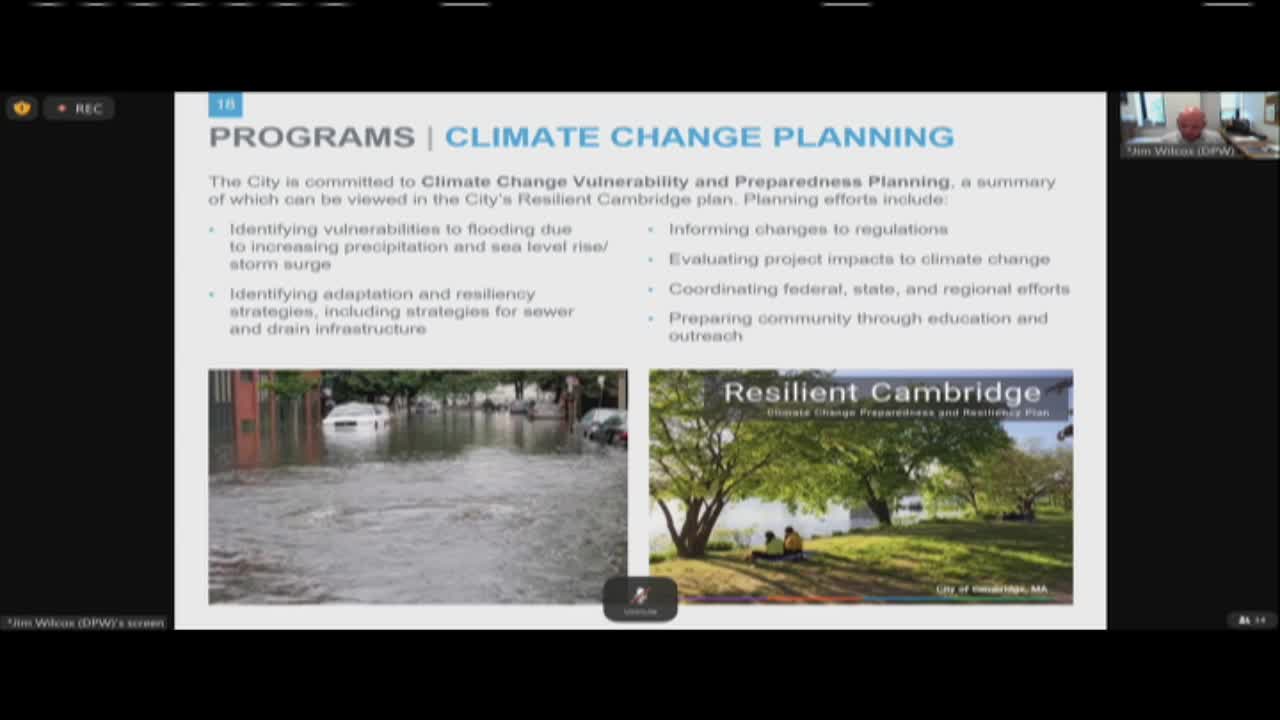City launches ambitious climate resilience initiatives to combat flooding
June 11, 2024 | Planning Board, Cambridge City, Middlesex County, Massachusetts

This article was created by AI summarizing key points discussed. AI makes mistakes, so for full details and context, please refer to the video of the full meeting. Please report any errors so we can fix them. Report an error »

In a recent government meeting, the Cambridge Department of Public Works (DPW) outlined significant initiatives aimed at addressing climate change impacts, particularly flooding and urban heat. The department emphasized that climate change planning is integrated into all projects, aligning with the city's Resilient Cambridge plan.
A key focus was on areas vulnerable to flooding, particularly in the Alewife, Port, and East Cambridge neighborhoods. The DPW presented a flood viewer tool, launched on September 1, 2023, which allows residents to identify flood-prone areas and understand long-term flood elevations necessary for compliance with new flood resiliency standards. These standards apply to various construction projects, ensuring that habitable spaces are protected from flooding and that materials used can withstand potential water damage.
Additionally, the DPW is tackling the urban heat island effect by increasing the number of street trees and implementing cool roofs and cool asphalt technologies. These efforts are part of a broader strategy to mitigate rising temperatures in the city, particularly on hot days.
The meeting also highlighted regional collaborations aimed at addressing coastal flooding risks associated with the Charles River and Mystic River dams. Although the intervention projects are outside Cambridge, they are crucial for protecting the city from potential flooding.
In a structural update, the DPW announced the integration of the electrical department into its operations, enhancing collaboration on city projects. The electrical division is now responsible for street lighting, fire alarm systems, and the installation of electric vehicle (EV) charging stations. The city aims to install 100 new EV charging heads by June 2027, with several locations already identified for 2024 installations.
Overall, the DPW's initiatives reflect a commitment to enhancing infrastructure resilience and sustainability in Cambridge, ensuring that the city is better prepared for future climate challenges.
A key focus was on areas vulnerable to flooding, particularly in the Alewife, Port, and East Cambridge neighborhoods. The DPW presented a flood viewer tool, launched on September 1, 2023, which allows residents to identify flood-prone areas and understand long-term flood elevations necessary for compliance with new flood resiliency standards. These standards apply to various construction projects, ensuring that habitable spaces are protected from flooding and that materials used can withstand potential water damage.
Additionally, the DPW is tackling the urban heat island effect by increasing the number of street trees and implementing cool roofs and cool asphalt technologies. These efforts are part of a broader strategy to mitigate rising temperatures in the city, particularly on hot days.
The meeting also highlighted regional collaborations aimed at addressing coastal flooding risks associated with the Charles River and Mystic River dams. Although the intervention projects are outside Cambridge, they are crucial for protecting the city from potential flooding.
In a structural update, the DPW announced the integration of the electrical department into its operations, enhancing collaboration on city projects. The electrical division is now responsible for street lighting, fire alarm systems, and the installation of electric vehicle (EV) charging stations. The city aims to install 100 new EV charging heads by June 2027, with several locations already identified for 2024 installations.
Overall, the DPW's initiatives reflect a commitment to enhancing infrastructure resilience and sustainability in Cambridge, ensuring that the city is better prepared for future climate challenges.
View full meeting
This article is based on a recent meeting—watch the full video and explore the complete transcript for deeper insights into the discussion.
View full meeting
